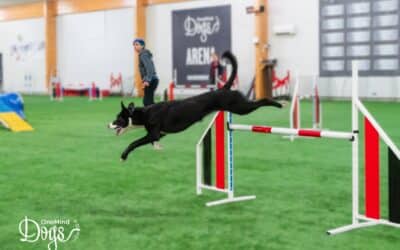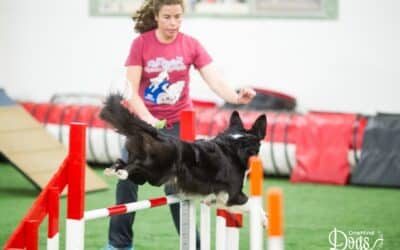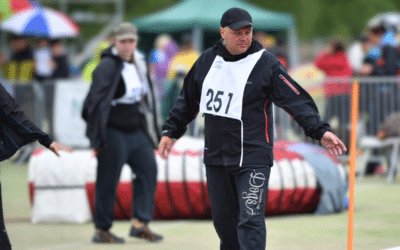Commitment in dog agility is more than just making sure your dog completes an obstacle—it’s about ensuring they do so with focus, independence, and precision. At OneMind Dogs, commitment is a core part of the “Three Cs”: Connect, Commit, and Cue. These elements form the foundation of proactive handling, ensuring smooth and efficient runs on the agility course.
Understanding the Three Cs of Dog Agility: Connect, Commit, Cue
The “Three Cs” are the bedrock of the OneMind Dogs methodology. These principles are designed to be applied consistently between every obstacle on the course to maintain a smooth and effective flow. By truly understanding and mastering these principles, handlers can enhance their agility performance and achieve better results.
Connect:
Connection is where everything begins. Without a solid connection between you and your dog, even the best-laid plans can quickly unravel. Connection ensures that your dog is focused on you, ready to take direction. However, connection is more than just eye contact; it involves using your body language, positioning, and subtle cues to communicate with your dog. This connection must be maintained before your dog can effectively commit to the next challenge.
For instance, by turning your head or shifting your body in a certain direction, you signal to your dog where you want them to go next. This connection is crucial because it keeps your dog in tune with you, ensuring they are always ready to respond to your cues. Without connection, your dog might lose focus, leading to slower response times or even mistakes on the course.
Commit:
Once your dog is connected with you, the next critical step is commitment. In agility, commitment refers to your dog locking onto the next obstacle and being ready to take it independently, allowing you to focus on the course ahead. The earlier your dog commits, the smoother and faster they can navigate the course.
Coach Beth Hostetter, a respected member of the OneMind Dogs coaching team, emphasizes that “It’s not how fast you can run, it’s how early you can leave.” Meaning that with strong obstacle commitment, even handlers who aren’t the fastest runners can stay ahead of their dogs on the course. Commitment is also about trust—you need to trust that once your dog has committed to an obstacle, they will stay committed while you leave to handle the next part of the course. Learn more in our popular webinar “Mastering commitment in dog agility”.
Building this level of trust and commitment involves consistent practice. Training exercises that focus on strengthening your dog’s commitment to obstacles can help ensure that they stay focused on the task at hand, even as you move on to the next part of the course. One effective method is placing a reward behind the obstacle, encouraging your dog to commit fully before you start moving on. As your dog’s commitment strengthens, you can begin giving them earlier cues for the next obstacle, allowing you to stay ahead on the course.
Cue:
The final element of the Three Cs is cueing. Once your dog is committed to an obstacle, you must provide clear cues for what comes next. Effective cueing is all about timing—your dog needs to know as early as possible what the next move is. This allows them to adjust their speed, direction, and focus, ensuring they stay on the right path and maintain momentum throughout the course.
Cueing is where the handler’s skill really comes into play. The more precise and timely your cues are, the more efficiently your dog will navigate the course. Having multiple handling techniques at your disposal is very beneficial in allowing you to cue the right path for you dog. This is especially important in competitive agility, where every second counts, and a missed cue can mean the difference between a clean run and a disqualification.
The Role of Obstacle Focus and Independence in Dog Agility
In addition to the Three Cs, OneMind Dogs emphasizes the importance of obstacle focus and independence. Obstacle focus refers to how much attention your dog gives to the obstacles versus their handler. Ideally, your dog should have a balance of obstacle focus (around 60%) and handler focus (around 40%, allowing them to perform obstacles independently while still being responsive to your cues.
Obstacle independence, on the other hand, is about your dog’s ability to complete an obstacle without needing constant guidance. This skill is crucial for advanced agility runs, where handlers need to focus on the course ahead rather than babysitting their dog through each obstacle. Training for independent obstacle performance allows your dog to focus on their job, freeing you to concentrate on the bigger picture.
Building and Proofing Commitment in Dog Agility
Developing strong commitment in your agility dog requires consistent training and proofing. One effective method is to place a reward behind the obstacle, encouraging your dog to commit fully before you start moving on to the next challenge. As your dog’s commitment strengthens, you can begin to give them earlier cues for the next obstacle, allowing you to stay ahead on the course.
OneMind Dogs method creators, Janita Leinonen and Jaakko Suoknuuti, have developed various exercises designed to enhance obstacle focus, commitment, and independence. These exercises improve agility performance and build the trust and teamwork that are essential for success on the course.
The Power of the Three Cs in Dog Agility
The Three Cs—Connect, Commit, Cue—are interconnected and essential for success in agility. By mastering these elements and focusing on building strong obstacle commitment, you can enhance your agility performance and deepen your bond with your dog. These principles ensure that your dog advances smoothly through the course, making agility not just a physical challenge but a mental one as well.
Checklist for Getting Ahead in Agility:
- Build strong obstacle focus.
- Have a clear “send” to commit the dog.
- Learn to recognize commitment from your dog.
- Train independent obstacle performance.
- Trust and leave!
This checklist serves as a guide to help you and your dog excel on the agility course. By following these steps, you can ensure that you are always one step ahead, leading to smoother, faster runs.
Watch the Three Cs in Action
Understanding and applying the Three Cs can significantly enhance your agility runs. To see these principles in action and learn more about how to implement them in your training, watch our Three Cs video. This resource will show you how to use Connect, Commit, and Cue to achieve optimum results on the agility course.
Join Us to Learn More
Commitment is just one part of the broader dog agility training approach at OneMind Dogs, but it’s a crucial one. By mastering the Three Cs and focusing on building strong obstacle commitment, you can take your agility skills—and your bond with your dog—to the next level.
If you missed Coach Beth Hostetter’s recent webinar on commitment, don’t worry—you can still access the key insights and training techniques shared in the recording. Join us at OneMind Dogs and discover how to unlock your dog’s full potential on the agility course. Watch the Webinar on Commitment in Dog Agility Now.



